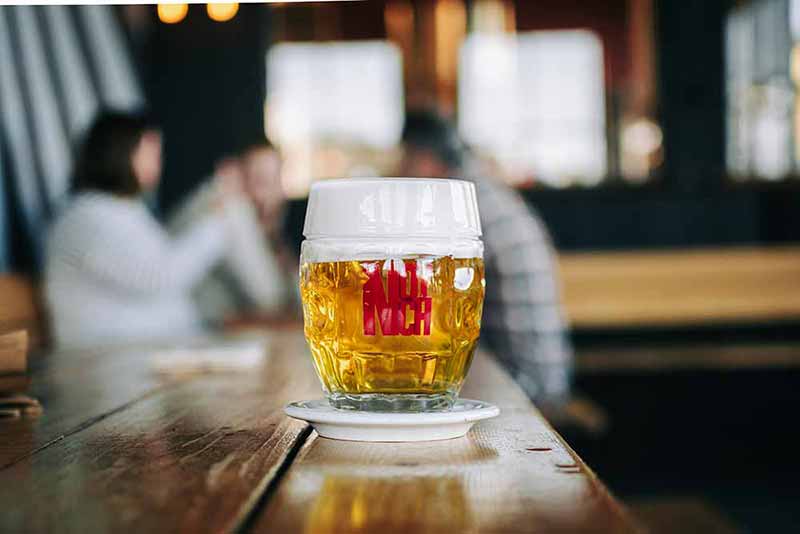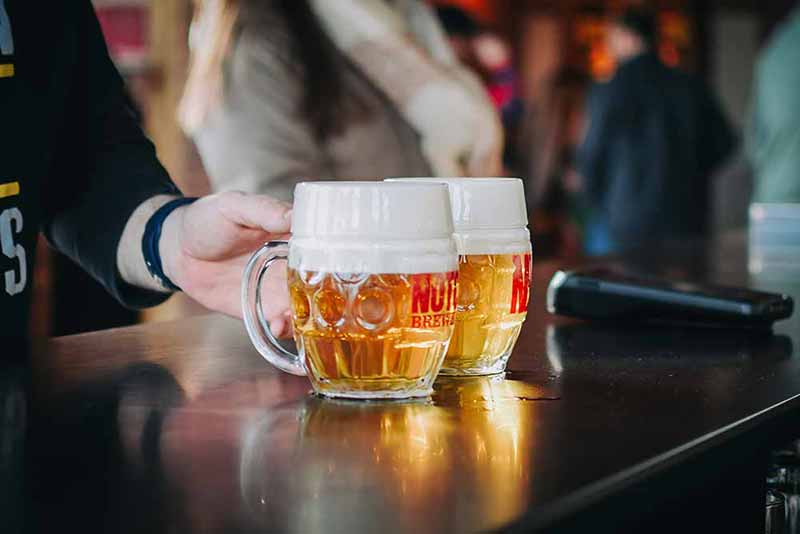
According to Untappd’s Top Ten Styles of 2021, pilsner ranked tenth with just over one million check ins in 2021. Consumers have increasingly shown an interest in the lower-ABV, higher-crushability beers. Although you’ll find Czech-, German-, and American-style pilsners on the shelves, don’t let that fool you. Not all pilsners are created equal.
In fact, American and German takes on the Czech-originated style are often vastly different. Brewers at Notch Brewing and Schilling Beer—who brew top-rated Czech pilsners—explain how to make a great, authentic Czech pilsner, the importance of decoction, and their favorite traditional versions of the style.
(Photography courtesy of Schilling Beer Co.)
What We’ll Cover in This Piece:
Affordable, Industry-Leading Brewery Software
Why Is a Czech Pilsner Hard to Define?

Photography courtesy of Rob Hughes | Notch Brewing
“[Czech pilsners] are hard to define,” says Notch Brewing Founder and Head Brewer Chris Lohring. “They are widely different. They can be malty. They can be dry. They can be hoppy.”
Lohring cites Pilsner Urquell and Budvar, both makers of the style, as proof of his claims.
“Those are two of the biggest breweries in the country and are polar opposites,” he says. “Budvar is malty, not a lot of hop character. And then Pilsner Urquell tends to be bitter, diacetyl and some hop aroma on the nose.”
Lohring says Budvar is an outlier to the style. Schilling Beer Co. Head Brewer Ryan Murphy is in that camp as well.
“The best version of a Czech pilsner I’ve had is Pilsner Urquell,” Murphy says, noting that he had it served from a tankovna pub (a bar that serves unfiltered beer) in the Czech Republic.
That version, he says, is unfiltered and unpasteurized, unlike the packaged product. But he says that beer is about as vintage as it gets for the style.
“It seems like it might be as close as possible to the more ancient versions,” Murphy says.
A classic style of a pale lager originating from Plzeň, Czech Republic, a Czech pilsner includes pale malts, hops, water, and yeast and cannot hide behind anything.
But emulating it is not the easiest of things, according to Lohring.
What Is a Czech Pilsner Grist?

Photography courtesy of @notchbrewing
Lohring, who has been brewing commercially for decades, says that there is a belief amongst brewers in the U.S. that a Czech pilsner is a SMaSH recipe. While you can focus on strictly pale malt, the long-time brewer provides his take on the grist.
“In my experience, single-malt pale lagers are less common than ones with a touch of caramel malts—like Carafoam, Carapils, or Carahell,” he says. “There’s no right or wrong. Both approaches are fine. But typically, it is ninety-five to ninety-nine percent pilsner malts.”
Murphy leans towards the addition of other grains outside of the pilsner malts.
“We have a little wiggle room for acidulated malts or Carafoam,” he says. “It’s a couple of percentage points of caramel malts—a dirty secret [in the Czech Republic]. Some brewers over there use five to eight percent of caramel malt to get deep gold color.”
Murphy says the reason for the caramel malt additions in the grist is to best emulate the version the brewers made over a century ago.
“And that’s largely due to huge gains that maltsters have made in creating these ultra-pale malts that wouldn’t have been available 100 or 150 years ago,” he says.
What About Decoction When Brewing a Czech Pilsner?

Photography courtesy of Schilling Beer Co.
Czech pilsners provide a very pronounced malt character. It’s different than German-style pilsners or U.S.-style pilsners. So the processes, ingredient selection, fermentation, and ultimately the final product all have to be considered, Lohring says.
“Some of that is through decoction,” he says. “Czech brewers won’t give you any respect if you don’t double and triple decoct your Czech pilsner. It’s inherent in their process.”
Murphy concurs, adding that this style is the ideal one to dip your toe in the decoction water.
“They really stress decoction in the Czech Republic as part of the mashing,” Murphy says. “If your brewery is designed to do decoction, Czech pilsner is an awesome beer to do that on.”
Decoction refers to a mashing procedure from a time when malt quality was not consistent and temperatures could not be measured. Boiling of the grain makes starches more accessible to enzymes, and this is important for under-modified malts—unlike modern malts—as the cell walls are not broken down as well.
Lohring, who has an encyclopedic knowledge of the process, explains that the boiling of a defined portion of the mash and returning it to the main mash to raise the temperature also helped the consistency in mashing temperatures before thermometers were available.
“You’ll often hear … brewers who cannot decoct, or chose not to, chime in with ‘decoction is no longer necessary due to advances in modern malting technology.’” Lohring says. “And they are not wrong. However, it is a convenient argument that, while true, does not touch on the most important byproduct of decoction: flavor and aroma improvement.”
The decoction process improves bitterness, reduces cold-break content, improves sedimentation, increases wort clarity, increases head retention, and most importantly, imparts melanoidin flavors of malty, toffee, bread, and caramel from the Maillard reaction, Lohring says.
“If your intent is to increase speed and lower expenses—you do not need decoction,” Lohring says. “But if your intent is to improve flavor and aroma, there is no substitute for what decoction brings.”
Most breweries, Lohring says, don’t have the capabilities to decoct, which for a Czech pilsner should be done at least twice, he says. He stresses that decoction is the most important process when making the style.
“Some can set up for a single decoction, but few can employ multiple decoctions,” Lohring says. “Czech brewers would never do less than two, never mind not at all.”
Which Hops Are Best in a Czech Pilsner?

Photography courtesy of Schilling Beer Co.
All noble hops. All the time.
Murphy says that Schilling does a sixty-minute boil for its Czech pilsner and uses a high-alpha acid German hop for bittering. They add another addition at around the half-hour mark and wrap up their hop schedule with a whirlpool addition of Czech Saaz.
“We shoot for 35 IBUs for a Czech pilsner,” Murphy says, noting that Schilling has a few Czech pilsners in its rotation. “We want 15 IBUs at our 20-30 addition. The whirlpool, we put about .6 to .75 pounds per barrel.”
Lohring says he prefers first wort hop additions, which lend a softer bitterness. Notch then adds a later addition near the end of the boil and never dry hops.
“We typically go for 35 IBUs for a 10° Plato Czech pilsner and roughly 40-45 IBUs for a 12° Plato version,” Lohring says.
As for varietals, Lohring says he leans heavily on Saaz, and domestically, they’ll use Sterling, a derivative of the Saaz hop here in the U.S.
“We don’t play around too much,” he says. “We get the best lot we can and roll with it.”
The Ideal Yeast for a Czech Pilsner

Photography courtesy of Schilling Beer Co.
Murphy says Schilling uses a few yeast strains for its Czech pilsner offerings. One is sourced directly from the Czech Republic. The other, he says, is a very popular German strain, though he didn’t divulge which.
Murphy says fermentation starts in the high forty degrees Fahrenheit, with a primary fermentation of about two weeks, depending on yeast health and vitality.
“We rise up to the mid-50s [degrees Fahrenheit] for a diacetyl rest,” he says. “Then lagering, we give unfiltered ones six to eight weeks, and filtered gets about four weeks.”
Lohring says the yeast selection is critical for creating the best Czech pilsner.
“Your Czech and German lager yeasts are different, and they provide different qualities,” he says. “A lot of U.S. brewers use 3470, which I think is the poorest choice you could possibly make.”
He says, ideally, you’ll use a Czech strain in your Czech pilsner. But Lohring says that if you use a German strain, it has to be expressive.
“Lagers are clean, but the yeast can have character,” Lohring adds. “Those two things aren’t mutually exclusive.”
Top Considerations When Brewing a Czech Pilsner

Photography courtesy of Rob Hughes | Notch Brewing
Murphy says that if you dabble in creating a Czech pilsner, especially if it’s for the first time, ensure you taste as many versions of that style as possible.
“With a beer like Czech pils, there are a lot of examples,” he says. “Try those, and then blend the reality of what the beer is served like in that area and what your customers’ palates are. You want to give them an experience.”
Murphy adds that you should stay authentic to the raw materials as you work towards this goal.
Lohring adds, “The way the beer is served … creates a dense, creamy foam that will lead to malt accentuation … I think that malt is really a defining character of Czech pilsners.”
One other thing to consider with creating the style, according to Lohring, is carbonation.
“Natural carbonation is a nice process [for this style],” he says. “You want a nice, creamy mouthfeel. It really helps to naturally carbonate the beer [to achieve that].”
Two Examples of a Great Czech Pilsner

Photography courtesy of @notchbrewing
Without hesitation, Murphy says the Palmovka Specialni is the Czech pilsner at Schilling that he was most proud of. The 5.5% ABV pilsner blended two different batches of Palmovka, fermented with different heirloom yeast strains. The beer features fresh baked bread notes and floral hops holding sway, and an expressive yeast character melds with light honey and hay on the palate.
“It’s as close to sitting down at a bar in Prague,” Murphy says.
At Notch, Lohring says they are most known for their 4.4% ABV The Standard Czech pilsner. Described as a classic 12° Plato Czech pale lager, this pilsner has notes of lemon, malt sweetness, and bread. If choosing for himself, Lohring says he’ll have the 4% ABV, triple-decocted Tenner.
“It shows you that a 4% ABV pale lager can be complex and keep you entertained,” he says. “I love that beer.”



